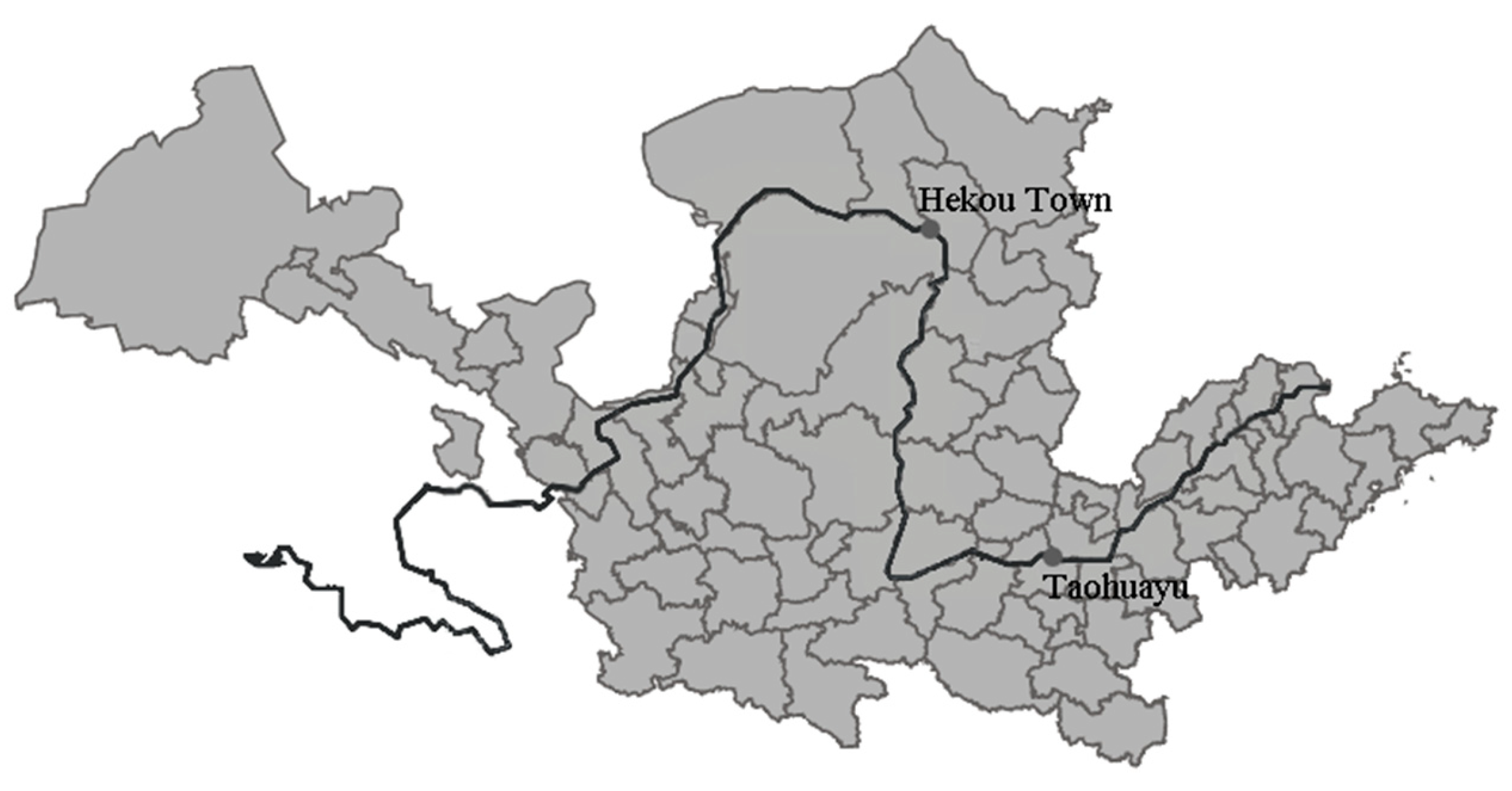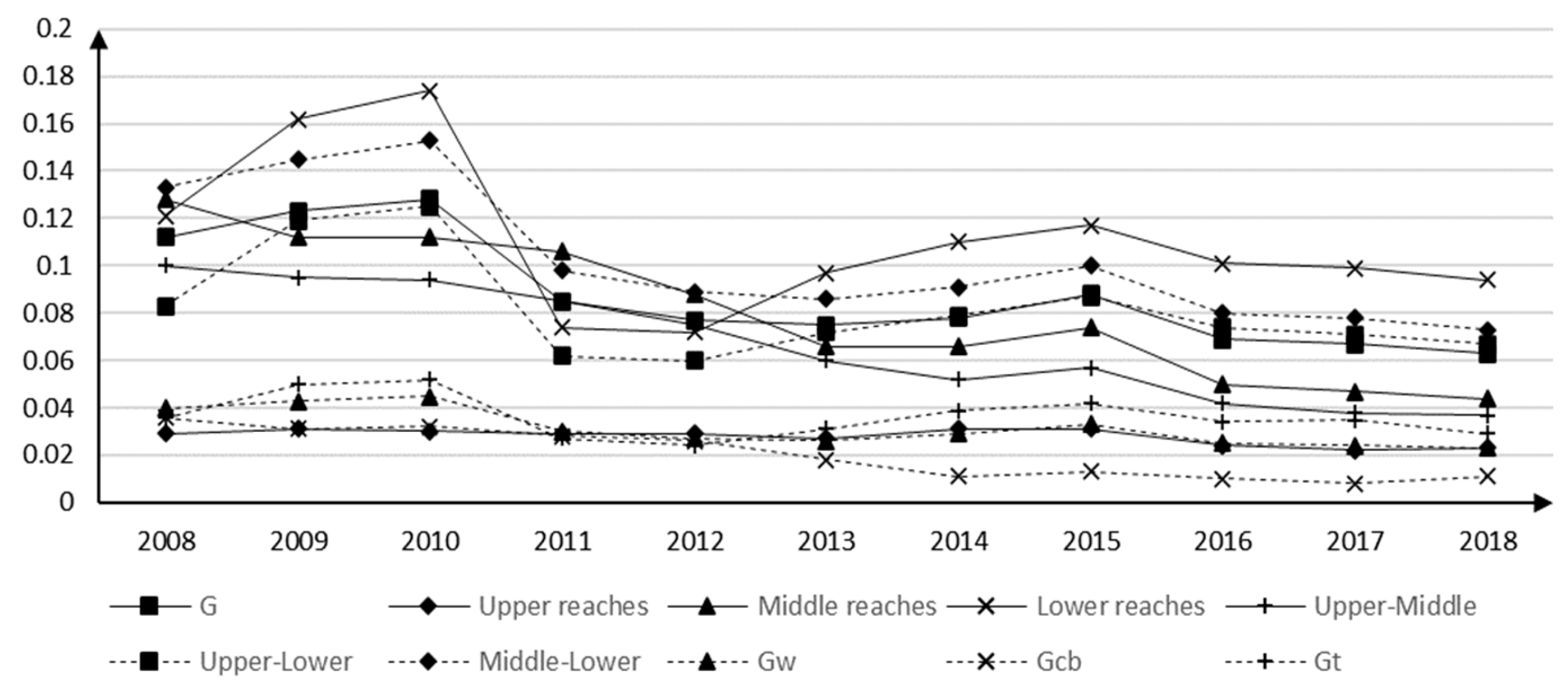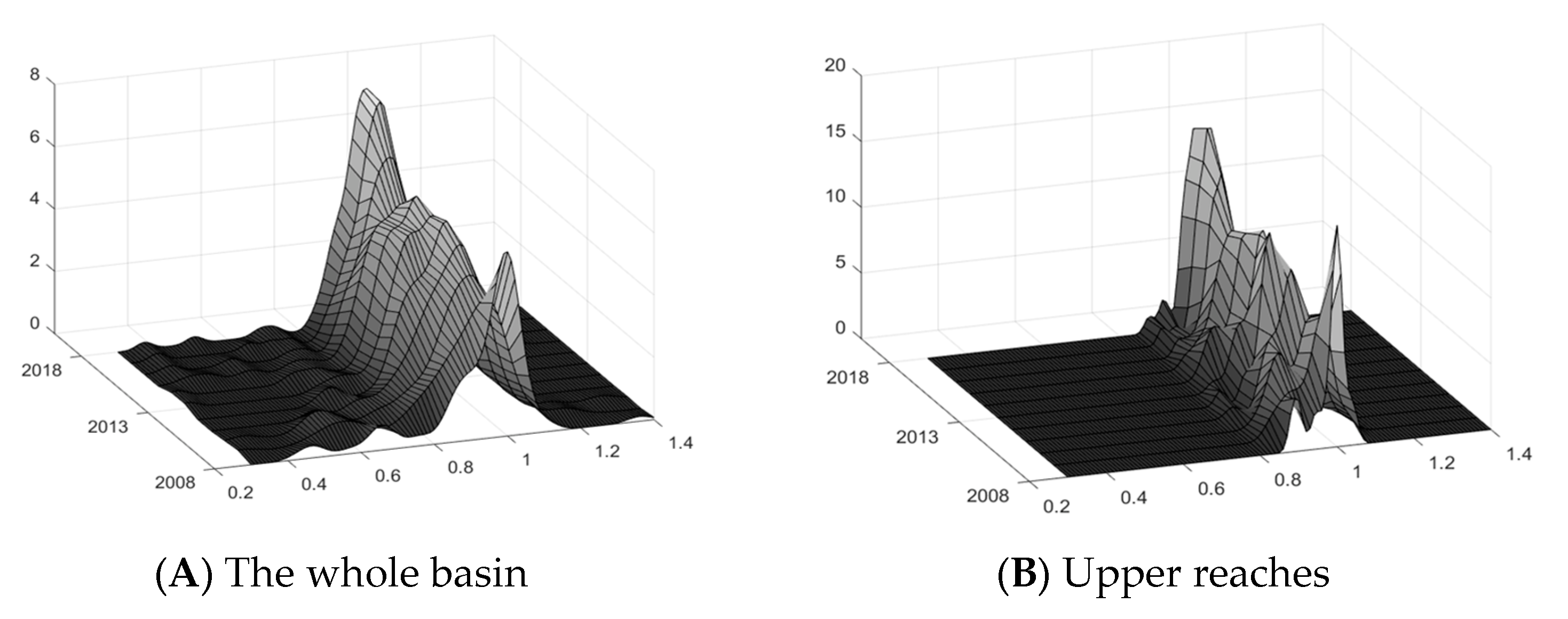Research on Spatial Difference, Distribution Dynamics and Influencing Factors of Urban Water-Use Efficiency in the Yellow River Basin
Abstract
:1. Introduction
2. Research Methods, Index Selection and Data Sources
2.1. Urban Water-Use Efficiency Measurement Methods and Indicators
2.2. Dagum Gini Coefficient and Its Decomposition
2.3. Kernel Density Estimation
2.4. Markov Chain and Space Markov Chain
2.5. Spatial Durbin Model
3. Empirical Results and Analysis
3.1. Spatiotemporal Characteristics and Evolution Trend of Urban Water Efficiency in the Yellow River Basin
3.2. Dynamic Evolution of Urban Water-Use Efficiency Distribution in the Yellow River Basin Based on Kernel Density Estimation
3.3. Dynamic Evolution of Urban Water-Use Efficiency Distribution in the Yellow River Basin Based on Markov Chain and Spatial Markov Chain Estimation
3.4. Analysis of Influencing Factors of Urban Water-Use Efficiency in the Yellow River Basin Based on the Spatial Durbin Model
4. Conclusions and Discussion
4.1. Conclusions
4.2. Discussion
Author Contributions
Funding
Institutional Review Board Statement
Informed Consent Statement
Data Availability Statement
Conflicts of Interest
References
- Lin, L.Y.; Luo, H.Y.; Li, Q.; Zhang, F.Y.; Zhou, L.; Shi, Y.; Zhang, Y.J. Analysis on the pollution characteristics and causes of river basin. Environ. Monit. China 2015, 2, 57–63. [Google Scholar]
- Ding, X.H.; He, J.H.; Wang, L.Y. Inter-provincial water resources utilization efficiency and its driving factors considering undesirable outputs: Based on SE-SBM and Tobit model. China Popul. Resour. Environ. 2018, 1, 157–164. [Google Scholar]
- Sun, D.Y.; She, J.W.; Liu, L.Y.; Wang, H.M. Efficiency evaluation for industrial water use and analysis of the spatio-temporal differences in the Yangtze River Delta urban agglomeration. Resour. Environ. Yangtze Basin 2018, 9, 1901–1908. [Google Scholar]
- Wang, B.; Gong, M.L. A Study on the Efficiency of Urban Water Resource System in China—Based on the analysis of network BAM model. Ind. Econ. Rev. 2017, 5, 133–148. [Google Scholar]
- Wang, M.; Sun, C.; Wang, X. Analysis of the water-energy coupling efficiency in China: Based on the three-stage SBM-DEA model with undesirable outputs. Water 2019, 11, 632. [Google Scholar] [CrossRef] [Green Version]
- Ren, Y.F.; Fang, W.Y.; Wang, Y.Q.; Wang, X.K.; OuYang, Z.Y. Analysis of urban water resources use efficiency in China. Acta Sci. Circumstantiae 2020, 4, 1507–1516. [Google Scholar]
- Han, W.Y.; Chen, X.P.; Zhang, Z.L.; Wang, N.F.; Yu, Y.H. Analysis on spatiotemporal structure of water resources utilization efficiency of the prefecture level cities and beyond in China. Res. Soil Water Conserv. 2018, 2, 354–360. [Google Scholar]
- Shi, T.G.; Zhang, X.L.; Du, H.R.; Shi, H. Urban water resource utilization efficiency in China. Chinese Geogr. Sci. 2015, 6, 684–697. [Google Scholar] [CrossRef] [Green Version]
- Wang, X.F. Study of Water Resources Efficiency by Considering the Regional Water Carrying Capacity. Urban Environ. Stud. 2018, 2, 97–110. [Google Scholar]
- Chu, J.; Wang, J.; Wang, C. A structure–efficiency based performance evaluation of the urban water cycle in northern China and its policy implications. Resour. Conserv. Recycl. 2015, 11, 1–11. [Google Scholar] [CrossRef]
- Kan, D.X.; Lyu, L.J. Empirical study on influence of urbanization on water resources utilization. Urban Probl. 2018, 7, 4–12. [Google Scholar]
- Zhu, D.; Tang, L.; Xie, Q.W.; Ma, M.; Rao, K.F. Efficiency assessment of water resource utilization in the Chinese provincial capital cities based on data envelopment analysis. Acta Ecol. Sin. 2020, 6, 1–11. [Google Scholar]
- Wang, S.Y.; Xu, Y.P.; Wang, D.Q.; Gao, B.; Lu, M.; Wang, Q. Effects of industry structures on water quality in different urbanized regions using an improved entropy-weighted matter-element methodology. Environ Sci Pollut Res. 2020, 27, 7549–7558. [Google Scholar] [CrossRef]
- Yu, Y.G.; Liu, L.Y. Regional differences and influence factors of water resource efficiency in China: Based on super efficiency DEA-Tobit. Econ. Geogr. 2017, 7, 12–19. [Google Scholar]
- Yue, L.; Cao, Y.; Lyu, R. Influencing factors and improvement paths of green water use efficiency in the Yellow River Basin: A new perspective based on ecogeographical divisions. Environ. Sci. Pollut. Res. 2022, 9, 1–15. [Google Scholar] [CrossRef]
- Wang, J.T.; Zhao, L. The Research of resource intensive efficiency and influencing factors of cities in China. China Popul. Resour. Environ. 2009, 5, 45–52. [Google Scholar]
- Zhao, F.O.; Wu, Y.P.; Ma, S.; Lei, X.H.; Liao, W.H. Increased water use efficiency in China and its drivers during 2000–2016. Ecosystems 2022, 1, 1–17. [Google Scholar] [CrossRef]
- Ren, J.L.; Li, H.; Wu, X.M.; Li, X.S. Analysis of water use efficiency in the capital cities of the Yangtze River economic zone. China Popul. Resour. Environ. 2016, 5, 101–107. [Google Scholar]
- Huang, J.; Yang, X.; Cheng, G.; Wang, S. A comprehensive eco-efficiency model and dynamics of regional eco-efficiency in China. J. Clean. Prod. 2014, 3, 228–238. [Google Scholar] [CrossRef]
- Tulkens, H.; Eeckaut, P.V. Non-parametric efficiency, progress and regress measures for panel data: Methodological aspects. Eur. J. Oper. Res. 1995, 3, 474–499. [Google Scholar] [CrossRef] [Green Version]
- Zhang, J.; Wu, G.Y.; Zhang, J.P. The Estimation of China's provincial capital stock: 1952–2000. Econ. Res. J. 2004, 10, 35–44. [Google Scholar]
- Dagum, C. A new approach to the decomposition of the Gini income inequality ratio. Empir. Econ. 1997, 4, 515–531. [Google Scholar] [CrossRef]
- Hai, X.; Li, W.F.; Wang, Z.; Zhou, W.Q.; Han, L.J.; Qian, Y.G. Interactions between water use efficiency and urbanization level in the Beijing-Tianjin-Hebei megaregion, China. Acta Ecol. Sin. 2018, 12, 4245–4256. [Google Scholar]
- Lee, L.; Yu, J. Estimation of spatial autoregressive panel data models with fixed effects. J. Econom. 2010, 2, 165–185. [Google Scholar] [CrossRef]
- Ma, X.; Xue, X.B.; Gonzalez-Meija, A.; Garland, J.; Cashdollar, J. Sustainable water systems for the city of tomorrow-A conceptual framework. Sustainability 2015, 9, 12071–12105. [Google Scholar] [CrossRef] [Green Version]
- Zhuang, Y.; Zhang, L.A.; Chiu, Y.H.; Guo, Z.Q.; Chu, Y.; Du, X.Y. Evaluating the recycling efficiency of industrial water use systems in China. J. Environ. Manag. 2022, 316, 115313. [Google Scholar] [CrossRef]
- Guo, Z.Q.; Tang, S.N.; Wang, D.J.; Zhang, J.Q. Spatial distribution and factors influencing ecological efficiency of the yellow river basin in China. Front. Environ. Sci. 2022, 3, 235. [Google Scholar] [CrossRef]




| Years | G | Upper | Middle | Lower | Upper-Middle | Upper-Lower | Middle-Lower | Gw | Gcb | Gt | Contribution Rate % | ||
|---|---|---|---|---|---|---|---|---|---|---|---|---|---|
| Gw | Gcb | Gt | |||||||||||
| 2008 | 0.112 | 0.029 | 0.128 | 0.121 | 0.100 | 0.083 | 0.133 | 0.040 | 0.036 | 0.036 | 35.6 | 31.8 | 32.5 |
| 2009 | 0.123 | 0.031 | 0.112 | 0.162 | 0.095 | 0.119 | 0.145 | 0.043 | 0.031 | 0.050 | 34.8 | 24.9 | 40.3 |
| 2010 | 0.128 | 0.030 | 0.112 | 0.174 | 0.094 | 0.125 | 0.153 | 0.045 | 0.032 | 0.052 | 35.0 | 24.7 | 40.3 |
| 2011 | 0.085 | 0.029 | 0.106 | 0.074 | 0.085 | 0.062 | 0.098 | 0.030 | 0.028 | 0.027 | 35.6 | 33.2 | 31.2 |
| 2012 | 0.077 | 0.029 | 0.088 | 0.072 | 0.075 | 0.060 | 0.089 | 0.027 | 0.026 | 0.024 | 35.3 | 33.9 | 30.9 |
| 2013 | 0.075 | 0.027 | 0.066 | 0.097 | 0.060 | 0.072 | 0.086 | 0.026 | 0.018 | 0.031 | 35.0 | 23.6 | 41.4 |
| 2014 | 0.078 | 0.031 | 0.066 | 0.110 | 0.052 | 0.079 | 0.091 | 0.029 | 0.011 | 0.039 | 36.7 | 13.6 | 49.7 |
| 2015 | 0.088 | 0.031 | 0.074 | 0.117 | 0.057 | 0.087 | 0.100 | 0.033 | 0.013 | 0.042 | 37.6 | 14.3 | 48.0 |
| 2016 | 0.069 | 0.024 | 0.050 | 0.101 | 0.042 | 0.074 | 0.080 | 0.025 | 0.010 | 0.034 | 36.5 | 14.1 | 49.4 |
| 2017 | 0.067 | 0.022 | 0.047 | 0.099 | 0.038 | 0.071 | 0.078 | 0.024 | 0.008 | 0.035 | 36.8 | 11.4 | 51.9 |
| 2018 | 0.063 | 0.023 | 0.044 | 0.094 | 0.037 | 0.067 | 0.073 | 0.023 | 0.011 | 0.029 | 36.8 | 16.9 | 46.3 |
| average | 0.088 | 0.028 | 0.081 | 0.111 | 0.067 | 0.082 | 0.102 | 0.031 | 0.020 | 0.036 | 36.0 | 22.0 | 42.0 |
| Space Lag | t/t + 1 | Type I | Type II | Type Ⅲ | Type IV |
|---|---|---|---|---|---|
| No | Ⅰ | 0.862 | 0.119 | 0.010 | 0.010 |
| Ⅱ | 0.120 | 0.735 | 0.120 | 0.025 | |
| Ⅲ | 0.010 | 0.120 | 0.720 | 0.150 | |
| Ⅳ | 0.014 | 0.019 | 0.143 | 0.824 | |
| Ⅰ | Ⅰ | 0.878 | 0.122 | 0.000 | 0.000 |
| Ⅱ | 0.151 | 0.755 | 0.075 | 0.019 | |
| Ⅲ | 0.045 | 0.273 | 0.545 | 0.136 | |
| Ⅳ | 0.020 | 0.040 | 0.100 | 0.840 | |
| Ⅱ | Ⅰ | 0.855 | 0.145 | 0.000 | 0.000 |
| Ⅱ | 0.058 | 0.855 | 0.072 | 0.014 | |
| Ⅲ | 0.032 | 0.097 | 0.710 | 0.161 | |
| Ⅳ | 0.023 | 0.023 | 0.186 | 0.767 | |
| Ⅲ | Ⅰ | 0.793 | 0.103 | 0.000 | 0.103 |
| Ⅱ | 0.040 | 0.800 | 0.140 | 0.020 | |
| Ⅲ | 0.000 | 0.045 | 0.833 | 0.121 | |
| Ⅳ | 0.036 | 0.089 | 0.214 | 0.661 | |
| Ⅳ | Ⅰ | 0.789 | 0.211 | 0.000 | 0.000 |
| Ⅱ | 0.000 | 0.793 | 0.207 | 0.000 | |
| Ⅲ | 0.000 | 0.038 | 0.875 | 0.088 | |
| Ⅳ | 0.018 | 0.000 | 0.107 | 0.875 |
| No Fixed Effect | Time and Space Dual Fixation | Time Fixed Effect | |||||||
|---|---|---|---|---|---|---|---|---|---|
| Coefficient | Standard Error | p-Value | Coefficient | Standard Error | p-Value | Coefficient | Standard Error | p-Value | |
| 0.088 | 4.666 | 0.000 | −0.017 | −0.358 | 0.720 | 0.038 | 1.083 | 0.279 | |
| −0.011 | −0.154 | 0.878 | 0.042 | 0.249 | 0.803 | −0.021 | −0.165 | 0.869 | |
| 0.003 | 0.809 | 0.419 | 0.010 | 2.609 | 0.009 | 0.008 | 2.172 | 0.030 | |
| −0.030 | −6.406 | 0.000 | 0.008 | 1.250 | 0.211 | −0.005 | −0.883 | 0.377 | |
| 0.000 | −0.403 | 0.687 | 0.000 | −0.139 | 0.890 | 0.000 | −0.183 | 0.855 | |
| −0.042 | −1.463 | 0.144 | 0.074 | 2.825 | 0.005 | 0.050 | 1.945 | 0.052 | |
| W × | −0.696 | −4.887 | 0.000 | −0.586 | −1.954 | 0.051 | −0.432 | −2.102 | 0.036 |
| W × | 1.383 | 2.724 | 0.007 | 3.463 | 3.007 | 0.003 | 1.905 | 2.181 | 0.029 |
| W × | 0.092 | 4.397 | 0.000 | 0.140 | 5.559 | 0.000 | 0.097 | 4.294 | 0.000 |
| W × | −0.227 | −7.154 | 0.000 | −0.037 | −0.672 | 0.502 | −0.217 | −6.135 | 0.000 |
| W × | 0.001 | 0.383 | 0.702 | −0.001 | −0.193 | 0.847 | −0.002 | −0.637 | 0.524 |
| W × | −0.040 | −0.278 | 0.781 | 0.126 | 0.667 | 0.505 | −0.118 | −0.671 | 0.502 |
| −0.640 | −3.571 | 0.000 | −0.069 | −0.458 | 0.647 | −0.106 | −0.695 | 0.487 | |
| teta | — | — | — | — | — | — | 0.193 | 9.192 | 0.000 |
| R2 | 0.226 | 0.771 | 0.738 | ||||||
| Spatial lag Wald test | — | 45.384 (0.000) | 48.634 (0.000) | ||||||
| Spatial lag LR test | — | 53.661 (0.000) | — | ||||||
| spatial error Wald test | — | 46.190 (0.000) | 48.982 (0.000) | ||||||
| spatial error LR test | — | 53.997 (0.000) | — | ||||||
| Variable | Direct Effect | Indirect Effect | Total Effect | |||
|---|---|---|---|---|---|---|
| Coefficient | T Value | Coefficient | T Value | Coefficient | T Value | |
| 0.039 | 1.115 | −0.397 | −2.059 | −0.358 | −1.862 | |
| −0.031 | −0.256 | 1.784 | 2.234 | 1.753 | 2.188 | |
| 0.007 | 2.052 | 0.090 | 3.731 | 0.097 | 4.101 | |
| −0.005 | −0.807 | −0.198 | −5.138 | −0.203 | −5.273 | |
| 0.000 | −0.125 | −0.002 | −0.612 | −0.002 | −0.624 | |
| 0.050 | 1.958 | −0.119 | −0.751 | −0.069 | −0.432 | |
Disclaimer/Publisher’s Note: The statements, opinions and data contained in all publications are solely those of the individual author(s) and contributor(s) and not of MDPI and/or the editor(s). MDPI and/or the editor(s) disclaim responsibility for any injury to people or property resulting from any ideas, methods, instructions or products referred to in the content. |
© 2022 by the authors. Licensee MDPI, Basel, Switzerland. This article is an open access article distributed under the terms and conditions of the Creative Commons Attribution (CC BY) license (https://creativecommons.org/licenses/by/4.0/).
Share and Cite
Ji, Z.; Yu, W. Research on Spatial Difference, Distribution Dynamics and Influencing Factors of Urban Water-Use Efficiency in the Yellow River Basin. Sustainability 2023, 15, 405. https://doi.org/10.3390/su15010405
Ji Z, Yu W. Research on Spatial Difference, Distribution Dynamics and Influencing Factors of Urban Water-Use Efficiency in the Yellow River Basin. Sustainability. 2023; 15(1):405. https://doi.org/10.3390/su15010405
Chicago/Turabian StyleJi, Zhiheng, and Wei Yu. 2023. "Research on Spatial Difference, Distribution Dynamics and Influencing Factors of Urban Water-Use Efficiency in the Yellow River Basin" Sustainability 15, no. 1: 405. https://doi.org/10.3390/su15010405




